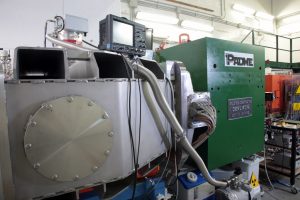There is strong astrophysical evidence that most of the matter making up the Universe is not “ordinary matter” (i.e. it is not constituted by particles described by the Standard Model). The most popular hypothesis among physicists is that it consists of a new kind of matter, electrically neutral and stable, which does not interact (at all or very weakly) with ordinary matter and therefore does not produce electromagnetic radiation, i.e. it is “dark”.
Many theoretical models envisage various types of dark matter. Among them, especially interesting is the possibility of the existence of a particular type of particle, similar to the carriers of interaction in known forces (such as the photon for electromagnetic force). This hypothetical particle would act as a “bridge” or “portal” between the “dark” particles of the new type of matter and the ordinary matter of the Standard Model, through a new, very weak force. One way to study this type of “dark” photon is searching its production in the annihilations of electrons and anti-electrons (positrons) in photon pairs, one of which ordinary and one dark.
PADME is a new experiment aiming to seek this type of event through the accurate reconstruction of the missing mass in the balance between the initial state, constituted by the electron-positron pair, and the final state in which only the ordinary photon is detected. For this purpose, the main detector is a so-called calorimeter, i.e. a device able to measure the deposited electromagnetic energy with great precision, at the same time ensuring determination of the direction of the particles hitting it.
To perform this research, PADME uses the positrons produced in the Beam Test Facility.
To produce an optimal number of interactions that generate dark photons compared to the background constituted by events due to “normal” electromagnetic interaction, a positron beam must be directed with great accuracy (as regards the direction of incidence and the point of impact) towards a target consisting of the electrons of the atoms of a very thin and light material. In our case, the material chosen is the Carbon of a synthetic diamond that in turn can be used as a detector.
All the experimental equipment must be in vacuum in order to minimize interactions with air molecules. Additionally, a magnetic field is needed to:
- sweep away from the calorimeter the beam of positrons that have not produced annihilations
- allow the events in which the positrons interact with the target producing only one photon by radiation (so-called “breaking” or Bremsstrahlung radiation) to be excluded.
The magnetic field, of the right intensity and with the volume required by PADME, is produced by a spare magnet made available by CERN in Geneva.
The experiment performed the first data taking in the period October 2018 – February 2019. These first collected data are now under analysis to allow the calibration of the different parts of the setup. To perform the measurement foreseen by PADME with the needed precision, it would be necessary to analyze the events corresponding to 1013 annihilations of positrons on target. This will require approximatively 2 years of data taking.
Research material “PADME: how it works”
Article from the magazine Asimmetrie “The dark side – Hunting the dark matter” by Mauro Raggi
Starting of the PADME experiment – 4th of October 2018
Translation by Camilla Paola Maglione, Communications Office INFN-LNF
 INFN-LNF Laboratori Nazionali di Frascati
INFN-LNF Laboratori Nazionali di Frascati
